While Maine is home to a diverse array of wildlife, there are only nine species of snakes found throughout the state. Most of these snakes are terrestrial snakes that are commonly encountered on land. In fact, only one of the nine species of snakes found in Maine is a true water snake from the genus Nerodia. The Northern water snake (Nerodia sipedon), is often found near bodies of water and is well adapted to swimming and hunting in aquatic environments. However, four of the remaining nine species of snakes, the Eastern garter snake, the Eastern ribbon snake, the Northern red-bellied snake, and the Northern brown snake, can be found in and around bodies of water in the Pine Tree State. You really needn’t beware of these five water snakes in Maine. Keep reading to learn how to identify these harmless, nonvenomous reptiles.
Northern Water Snake
The Northern water snake (Nerodia sipedon) is a semiaquatic species of snake that can be found in various aquatic habitats across much of North America, including Maine. Nerodia sipedonis the only species of true water snake in the state. It is a nonvenomous snake that can grow up to four feet (1.2 m) long. The Northern water snake has a dark brown or grayish-black body with reddish-brown or black bands along its sides.
One of the most notable features of the Northern water snake is its behavior when threatened. When threatened, it will often flatten its body and raise its head. This makes it appear larger and more intimidating to potential predators. In addition, it may emit a musky odor and strike repeatedly in an attempt to defend itself.
Contrary to appearances, the Northern water snake is generally harmless to humans. While it may bite if provoked, its bite is not venomous and is unlikely to cause serious injury. In fact, the Northern water snake is considered beneficial to humans in many ways. It feeds on a variety of aquatic animals such as fish, frogs, and crayfish. This helps control the populations of these animals.
The Northern water snake is a fascinating species that plays an important role in Maine’s aquatic ecosystems.
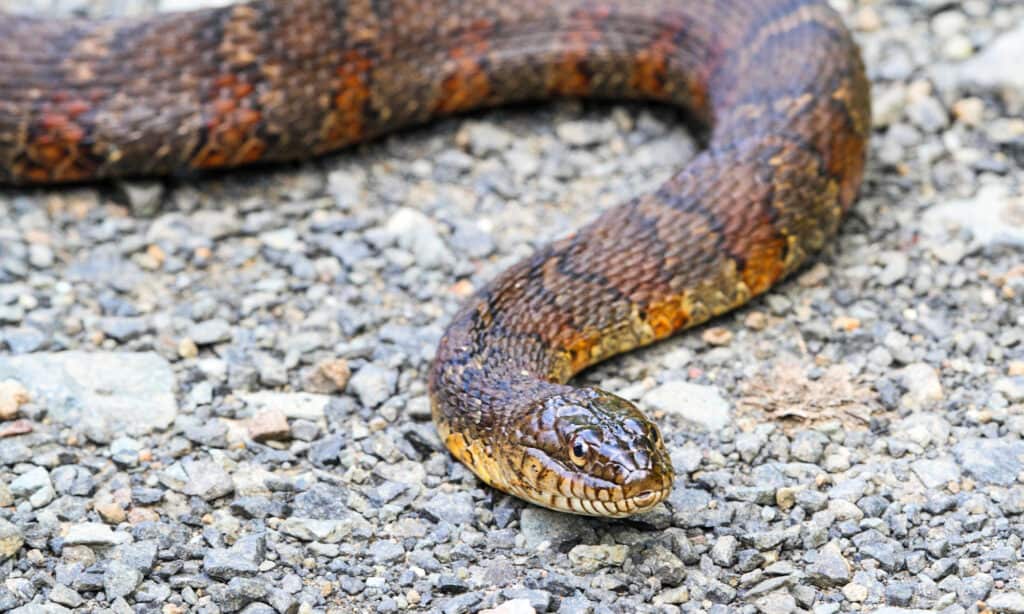
Contrary to appearances, the Northern water snake is generally harmless to humans.
©Steve Byland/Shutterstock.com
Eastern Garter Snake
The Eastern garter snake (Thamnophis sirtalis) is a common species of nonvenomous snake found throughout much of North America, including the Eastern United States and parts of Canada. These snakes are relatively small, typically reaching lengths of around 18-26 inches (45-66 cm). Eastern garter snakes have a slender build with distinctively patterned bodies. Their coloration is typically a series of horizontal stripes that run the length of their body. Black, brown, green, or gray are the dominant body colors. The stripes may be yellow, white, or red, and are often bordered by black or dark brown. The head of the Eastern garter snake is relatively small. They have large eyes and a slightly upturned snout. , Eastern garter snakes are quite cold-tolerant which allows them to be active earlier and later in the year than other species.
They are active during the day and are commonly found in a variety of habitats, including woodlands, fields, and wetlands. Eastern garter snakes can often be found around water sources, such as ponds, streams, and wetlands. While this species is primarily terrestrial and spends much of its time on land, it is also a competent swimmer and can move easily through shallow water. Water provides an important habitat and foraging opportunities for garter snakes. They prey upon amphibians, small fish, and aquatic invertebrates.
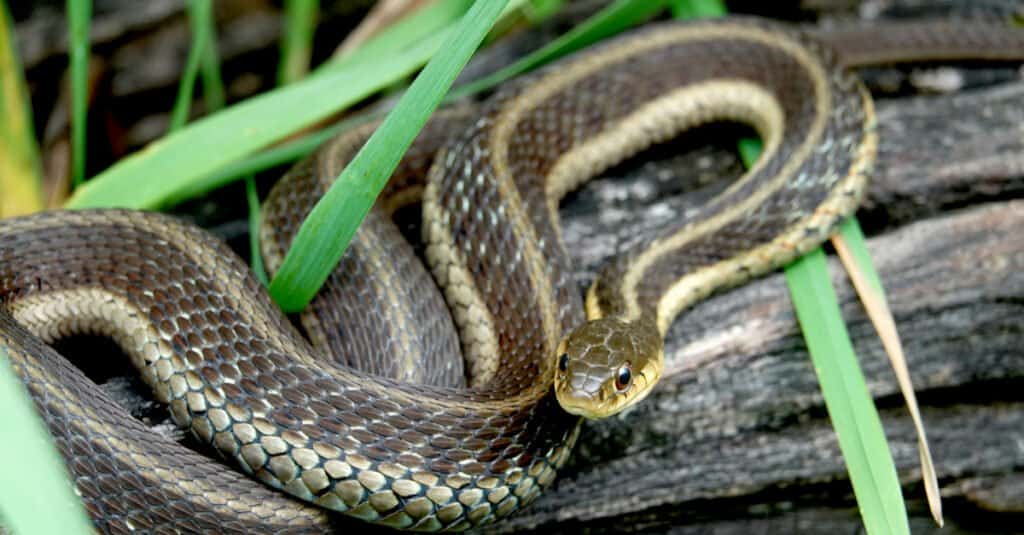
One of the most cold-tolerant snakes in the world, Eastern garter snakes are usually active early and later in the year than other species.
©Erik Agar/Shutterstock.com
Eastern Ribbon Snake
Eastern ribbon snakes (Thamnophis sauritus sauritus) are found near bodies of water in Maine. This species is known to be semi-aquatic and is often found in or near wetland habitats. It is found in marshes, swamps, and ponds. Eastern ribbon snakes are generally associated with habitats that have abundant vegetation which they use for foraging and shelter.
In Maine, Eastern ribbon snakes are typically found in the Southern and Central parts of the state. They are relatively small snakes, typically measuring between 20 and 30 inches (50-76 cm) in length. Eastern ribbon snakes are slender, brightly colored snakes. They are generally olive to brown in color, with a distinctive yellow or orange strip running along their sides and a light-colored belly. Eastern ribbon snakes are diurnal. They are found near water, where they feed on a variety of aquatic and semi-aquatic prey. They are relatively shy and will often retreat to the water or nearby vegetation if they feel threatened.
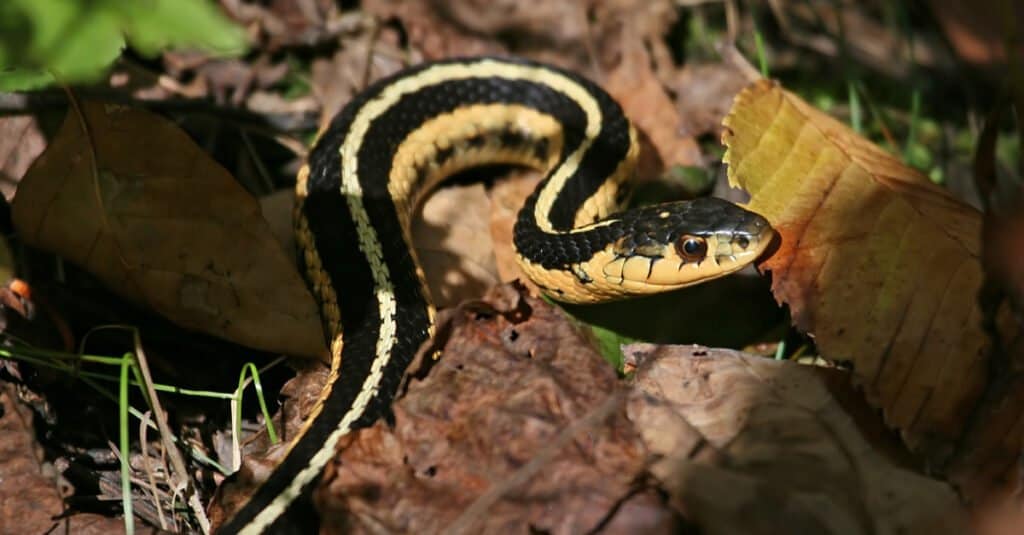
Eastern ribbon snakes (
Thamnophis sauritus sauritus) are found near bodies of water in Maine
©John Czenke/Shutterstock.com
Northern Red-bellied Snake
Northern red-bellied snakes (Storeria occipitomaculata occipitomaculata) are small, non-venomous snakes. They can be found in various habitats throughout eastern North America, including Maine.
In Maine, Northern red-bellied snakes are typically found in areas with moist soils and dense vegetation. These include wetlands, marshes, bogs, and forested areas near water sources. Look for red-bellied snakes near streams, ponds, and lakes. They prefer areas that have abundant leaf litter or other forms of ground cover. This provides cover and foraging opportunities for these small snakes.
Northern red-bellied snakes are relatively small, typically measuring 7-11 inches (17-28 cm) long. They are recognized by their reddish-brown back and sides, which are often marked with a series of darker spots or blotches, and their bright red or pink bellies. They are active during the day and at night, feeding on a variety of small invertebrates like slugs, snails, and earthworms.
While Northern red-bellied snakes are relatively common in Maine and other parts of their range, they can be difficult to spot due to their small size and cryptic coloration. They are an important part of Maine’s ecosystem, however, as they help to control populations of small invertebrates and provide food for larger predators like birds and mammals.
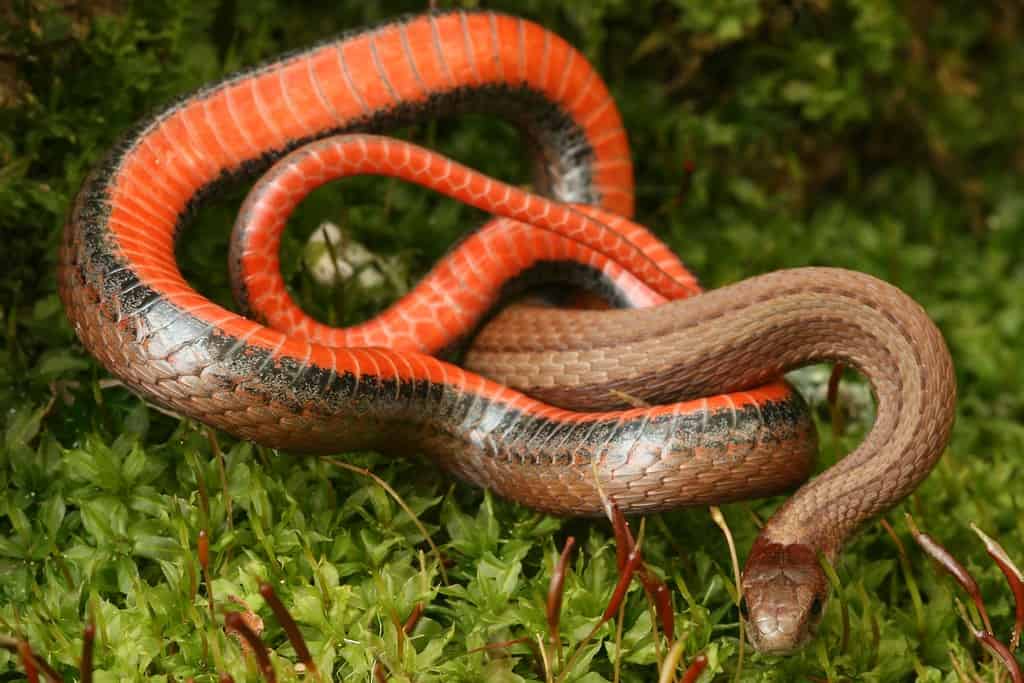
Northern red-bellied snakes are relatively small, typically measuring 7-11 inches (17-28 cm) long.
©Kevin Collison/Shutterstock.com
Northern Brown Snake
Storeria dekayi dekayi, Northern brown snakes are not considered a semiaquatic species, though they may be found near bodies of water in Maine and other parts of their range. These snakes are generally found in a variety of habitats, including forests, fields, and wetlands, where they can hunt for prey such as earthworms, slugs, and snails.
Northern brown snakes are relatively small, typically measuring between 9 and 13 inches (22-33 cm) in length. Northern brown snakes are brown or gray with two rows of small, dark spots running down their backs. They are active during the day and are relatively docile and slow-moving.
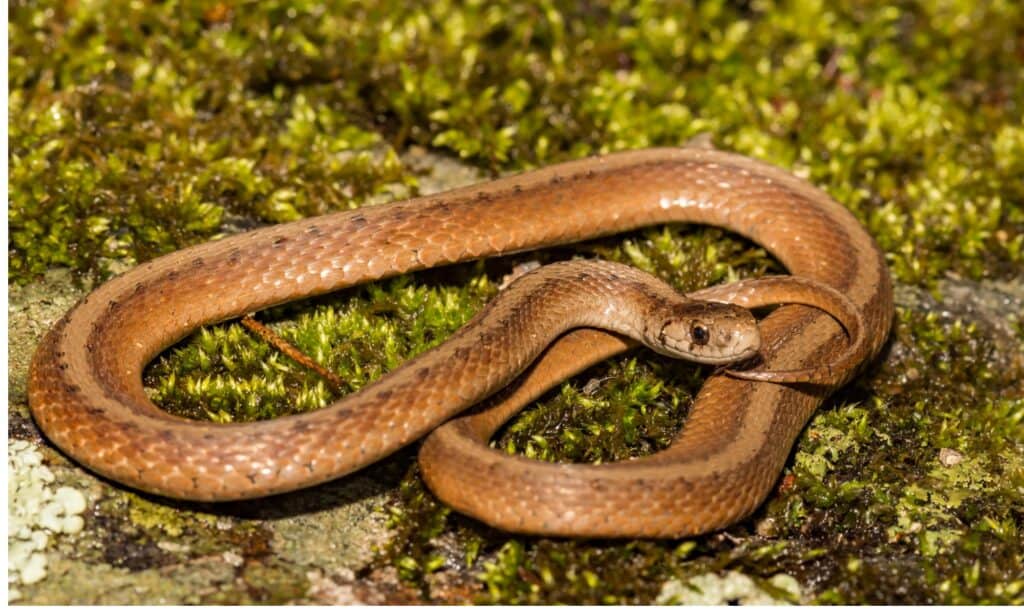
Northern brown snakes are brown or gray with two rows of small, dark spots running down their backs.
©iStock.com/JasonOndreicka
The photo featured at the top of this post is © Steve Byland/Shutterstock.com
Thank you for reading! Have some feedback for us? Contact the AZ Animals editorial team.






